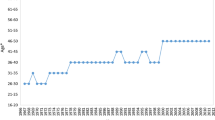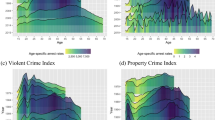Abstract
This paper assesses the state of life-course criminology and argues that its major limitation to date is the general failure to incorporate social change. Invoking the concept of cohort differences in aging because of macro-level change, I discuss some of the watershed changes of recent times, including the historic crime decline, the technological revolution, massive immigration and urbanization, rises in inequality, and the Great Recession. I then introduce a new study from Chicago that attempts to link individual development and pathways of crime to some of these large-scale social changes, capitalizing on a cohort sequential design from the Project on Human Development in Chicago Neighborhoods. I conclude with implications for global criminology, especially the role of urbanization, ethnic diversity, and inequality in Asia.

Similar content being viewed by others
Notes
For a recent assessment of the status of the age-graded theory of informal social control, see Laub et al. (2015, forthcoming).
The following section draws from Sampson (2015).
To date, there have been over 450 publications based on the PHDCN data, the first three waves of which are publicly available at the University of Michigan’s ICPSR. For further information on data access and publications, see http://www.icpsr.umich.edu/icpsrweb/PHDCN/.
Amy Tsang is a doctoral candidate in sociology at Harvard University, and author of “Who is an ‘Urban Person’? Subjective Identification versus Official Classification of Place-Status in Contemporary China,” unpublished manuscript, Department of Sociology.
References
Collier, P. (2013). Exodus: how migration is changing our world. New York: Oxford University Press.
Ehrenhalt, A. (2012). The great inversion and the future of the American city. New York: Knopf.
Elder, G. H., Jr. (1974). Children of the Great Depression: Social change in life experience. Chicago: University of Chicago Press.
Elder, G. H., Jr. (1985). Perspectives on the life course. In G. H. Elder Jr. (Ed.), Life course dynamics. Ithaca: Cornell University Press.
Elder, G. H., Jr. (1998). The life course as developmental theory. Child Development, 69, 1–12.
Ellen I, E., & O’Regan, K. (2009). Crime and U.S. cities: recent patterns and implications–the shape of the new American city. Annals of the American Academy of Social and Political Science, 626, 22–38.
Farrington, D. P. (2013). Longitudinal and experimental research in criminology. In Crime and justice in America 1975–2025 (pp. 453–527) edited by M. Tonry. Chicago: University of Chicago Press.
Gibson, C. L., & Krohn, M. D. (Eds.). (2013). Handbook of life-course criminology: Emerging trends and directions for future research. New York: Springer.
Glaeser, E. L. (2011). The triumph of cities: How our greatest invention makes us richer, smarter, greener, healthier, and happier. New York: Penguin.
Haberman, C. (2014). When youth violence spurred ‘superpredator’ fear. New York Times: April 6.
Hirschi, T. (1969). Causes of delinquency. Berkeley: University of California Press.
Katz, M. B. (2012). Why don’t American cities burn? Philadelphia: University of Pennsylvania Press.
Laub, J. H., & Sampson, R. J. (2003). Shared beginnings, divergent lives: Delinquent boys to age 70. Cambridge: Harvard University Press.
Laub, J. H., & Sampson, R. J. (2008). Glen elder’s influence on life-course criminology: serendipity and cross-disciplinary fertilization. Research in Human Development, 5, 199–215.
Laub, J. H., Rowan, Z., & Sampson, R. J. (2015). "The status of the age-graded theory of informal social control." In Oxford handbook of developmental and life-course criminology, edited by D.P. Farrington. New York: Oxford University Press, forthcoming.
Liberman, A. M. (Ed.). (2008). The long view of crime: A synthesis of longitudinal research. New York: Springer.
Logan, J. R., & Zhang, C. (2010). Global neighborhoods: new pathways to diversity and separation. American Journal of Sociology, 115, 1069–1109.
Pettit, B., & Western, B. (2004). Mass imprisonment and the life course: race and class inequality in U.S. incarceration. American Sociological Review, 69, 151–169.
Piketty, T. (2014). Capital in the twenty-first century. Cambridge: Harvard University Press.
Pinker, S. (2012). The better angels of our nature: Why violence has declined. New York: Penguin.
Piquero, A. R., & Mazarolle, P. (Eds.). (2000). Life-course criminology. Belmont: Wadsworth.
Piquero, A., Farrington, D., & Blumstein, A. (2007). Key issues in criminal career research: New analyses of the Cambridge study in delinquent development. Cambridge: Cambridge University Press.
Putnam, R. (2007). E Pluribus Unum: diversity and community in the 21st century: the 2006 Johan Skytte prize lecture. Scandinavian Political Studies, 30, 137–174.
Riley, M. W. (1987). On the significance of age in sociology. American Sociological Review, 52, 1–14.
Ryder, N. (1965). The cohort as a concept in the study of social change. American Sociological Review, 30, 843–861.
Sampson, R. J. (2012). Great American city: Chicago and the enduring neighborhood effect. Chicago: University of Chicago Press.
Sampson, R. J. (2013). The place of context: a theory and strategy for criminology’s hard problems. (2012 Presidential Address to the American Society of Criminology). Criminology, 51, 1–31.
Sampson, R. J. (2015). Immigration and America’s urban revival. American Prospect Summer: 20–24.
Sampson, R. J., & Laub, J. H. (1990). Crime and deviance over the life course: the salience of adult social bonds. American Sociological Review, 55, 609–627.
Sampson, R. J., & Laub, J. H. (1993). Crime in the making: Pathways and turning points through life. Cambridge: Harvard University Press.
Sampson, R. J., & Laub, J. H. (2016). The legacy of the 1986 criminal careers report: turning points and the future of life-course criminology. Journal of Research in Crime and Delinquency, 53, forthcoming.
Sharkey, P. (2012). An alternative approach to addressing selection into and out of social settings: neighborhood change and African American children’s economic outcomes. Sociological Methods and Research, 41, 251–293.
Sharkey, P. S., & Sampson, R. J. (2015). Violence, cognition, and neighborhood inequality in America. In Social neuroscience: Brain, mind, and society (pp. 320–339), edited by R. K. Schutt, L. J. Seidman and M. S. Keshavan. Cambridge: Harvard University Press.
Sugrue, T., & Vitiello, D (Eds.) (2015). Immigration and metropolitan revitalization. Philadelphia: University of Pennsylvania Press, forthcoming.
Travis, J., Western, B., & Redburn, S. (Eds.). (2014). The growth of incarceration in the United States: Exploring causes and consequences. National research council. Washington: The National Academies Press.
Whyte, M. (Ed.). (2010). One country, two societies: Rural–urban inequality in contemporary China. Cambridge: Harvard University Press.
Wilson, J. Q., & Kelling, G. (1982). Broken windows: the police and neighborhood safety. Atlantic, 127, 29–38.
Wilson, W. J. [1987]. (2012). The truly disadvantaged: The inner city, the underclass, and public policy. Chicago: University of Chicago Press.
Author information
Authors and Affiliations
Corresponding author
Ethics declarations
Conflict of Interest
The author declares that he has no competing interests.
Ethical Approval
Data collection procedures performed in the PHDCN involving human participants were in accordance with the ethical standards of the institutional review board and with the 1964 Helsinki declaration and its later amendments or comparable ethical standards.
Informed Consent
Informed consent was obtained from all individual participants included in the study.
Rights and permissions
About this article
Cite this article
Sampson, R.J. Crime and the Life Course in a Changing World: Insights from Chicago and Implications for Global Criminology. Asian Criminology 10, 277–286 (2015). https://doi.org/10.1007/s11417-015-9220-3
Received:
Accepted:
Published:
Issue Date:
DOI: https://doi.org/10.1007/s11417-015-9220-3




